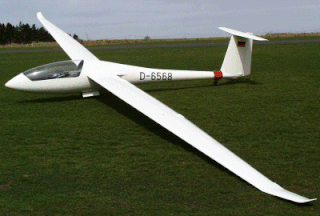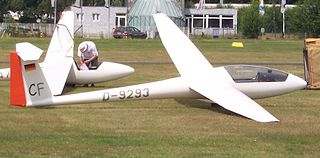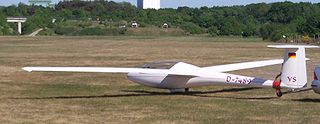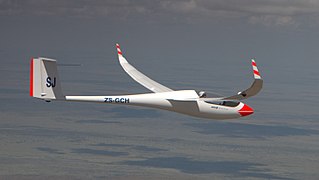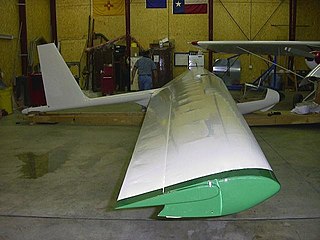History
Open Class
The Open Class is the oldest competition class, although it only came into formal existence with the creation of the two-seater class in the early 1950s.
This unrestricted class has been a favourite testing ground for technological innovation. Many research prototypes fall under this class definition, e.g. the Akaflieg Darmstadt D-30 of 1938, which had variable-dihedral wings and spars built of light alloys, the extremely large-span SB-10 of 1972, the telescoping-wing Akaflieg Stuttgart FS-29 of 1975 and the solar-powered Icare.
In contests, the Open Class usually delivers the top performances, with daily tasks as far as 1000 km being possible in favourable weather. To be successful, however, an Open Class glider must blend high performance with practicality. "Extreme" designs tend to be failures, of which the Austria of 1931, the Sigma of 1971 and the BJ series are but the most conspicuous examples. Arguably the only [Notes 1] 'extreme' glider that ever won a World Championships was the Nimbus I.
Until the 1960s, a fair number of gliders were able to do well in open competition, with smaller-span types occasionally beating larger but more cumbersome types. The composite revolution caused a shake-down, further aggravated when the ASW 22 and Nimbus-3 were introduced in 1981, after which the Open Class for a while became the exclusive preserve of only two manufacturers. [Notes 2] The World Gliding Championships of 2012 brought into competition new designs, some of significantly lower wingspan, [Notes 3] which flew successfully [Notes 4] against "traditional" (wingspan 28 m+) machines of this class. [2]
Following a couple of decades of small, incremental performance gains, the appearance in 2000 of the eta brought a sudden jump in performance and a further price escalation. This very expensive aircraft has up to now not had outstanding success in competition, [Notes 5] but it for a while seemed to impact the cost of remaining competitive in the class. The 'eta biter' [Notes 6] [3] and its successor, the Concordia [Notes 7] single-seater, as well as Walter Binder's EB28/EB29 until 2012 were being presented [4] as challengers to eta, [Notes 8] but the appearance and performance [Notes 9] [2] of shorter wingspan competitors in World Gliding Championships of 2012 may change established views on the design trends.
In July 2007, the IGC increased the maximum weight allowed in the Open Class to 850 kg provided the aircraft has a valid certificate of airworthiness at that weight, i.e. the manufacturers must re-certify the glider.
Standard Class
The Standard Class was introduced in the late fifties as an alternative to the increasingly heavy, difficult to fly and costly Open Class ships of that time. Striving for affordability and simplicity, the original standard class rules restricted the span to 15 metres and ruled out retractable undercarriages, flight-disposable ballast, radios and lift-enhancing devices such as flaps. The archetypal embodiment of these rules is the Ka 6.
Technological change was fast-paced in the years following the introduction of the Standard Class. The transition to fibreglass construction made the existing rules increasingly awkward. The stronger composite structures allowed higher wing loadings, and competitors resorted to fixed ballast to exploit this competitive advantage, which of course increased landing speeds and the risk of damage when alighting in unprepared fields. The fixed undercarriages caused a major fraction of the drag of sleek fibreglass airframes. Designers reacted by recessing the wheels into the fuselage, which further increased the risk of ground-related damage. Manufacturers took to arguing that the single cheapest way to increase performance was to retract the wheel.
In view of these safety and cost-related arguments, the Standard Class rules were updated to allow disposable water ballast and retractable undercarriages. Retractable wheels were allowed by 1970 and water ballast by 1972. Manufacturers were fitting these as production items, and they had to be disabled to fly in competitions.
In 1965 the American Richard Schreder flew a variant of his HP-11, which in normal form had simple flaps as airbrakes. To comply with the rules, the ship was modified for the World Championships so that the outer half of the flaps hinged upwards to comply with the rules. Schreder pointed out that this made the glider more expensive and less safe (higher landing speed, less effective brakes). The argument over whether to allow this went on for the next five years in IGC and eventually the rules were changed to permit plain flaps provided they were the only means of drag control for landing, and there was no aileron linking for camber changing. There were no other limits on using the flaps for lift increase (although the lack of aileron linking meant that the flaps were not as effective as they might have been).
A later concession would bring difficulties in that the demarcation line between airbrake/landing flaps and performance enhancing flaps is vague. The reluctance within the IGC to allow the later in the Standard Class led to an unsuccessful attempt to codify what constitutes a landing flap. After the LS2 and the PIK-20 exploited this loophole to win the 1974 and 1976 World Championships in the Standard Class, the IGC banned all camber-changing devices from the class and created a parallel 15 metre Class to accommodate them. This decision was polemic as it was the second rule change in a few years and it orphaned several glider types that did not fit well within either class definition (especially the PIK-20 and the Libelle that had been built in large numbers). Notwithstanding, the decision was vindicated by the great success subsequently enjoyed by both the Standard and 15 metre classes.
Some significant Standard Class types have been the Ka 6 and Mucha (1958), the LS1 (1967), the Standard Cirrus (1969), the LS4 (1980) and the Discus (1984). Modern contenders include the Discus 2 (1998), LS8 (1995) and ASW 28 (2000)
15 metre Class
This class was created specifically to end the trailing-edge airbrake controversy in the Standard Class. The class has been very successful, being since its inception a feature of all World and European Championships. Technological development has eroded the performance gap that once existed between the Standard and 15-metre classes, which today is perceptible only in strong gliding weather. Some observers argue that the difference is not meaningful enough, that the 18 metre class is the natural successor to the 15 metre class and that the latter should be removed from World Championships to give space to new classes. Notwithstanding, the class has a sizeable following and official support into the foreseeable future.
Significant 15 metre types include the ASW 20 (1977), Ventus (1980), LS6 (1983). Modern contenders include the Ventus-2 (1994), the ASW-27 (1995) and Diana 2 (2005).
18 metre Class
The availability of carbon fibre at affordable prices has allowed the manufacture of light and economical spans exceeding 15 metres. Manufacturers started to exploit this potential by offering tip extensions for their flapped sailplanes. Spans increased gradually from 16.6 metres in the first implementations (ASW 20L and Ventus b 16.6) to 17 metres (DG-200/17, DG-600, Glasflügel 403), 17.5 metres (LS6-c), finally settling on 18 metres. The trend towards turbo and self-launching sailplanes also favours the 18 metre span, which is large enough to carry the additional weight of the power unit without impairing the ability to climb in weak lift.
Following a decade of contests at regional level, which permitted the resolution of issues such as mixed glider/motorglider competition, this class came to feature for the first time in a World Championships in 2001, with a maximum all-up weight of 600 kg.
Significant 18 metre types include the Schleicher ASG 29 (2005), Schempp-Hirth Ventus-2 (1995), and the Jonker JS-1 (2007). The same three manufacturers have since introduced new types which are competitive in both the 15 and 18 metre classes with interchangeable wing tips: the AS 33 (2020), the Ventus-3 (2016), and the JS-3 (2017).
Two Seater Class
A two-seater class appeared for the first time in a World Championships in 1952. The reason for having a separate class was that the drag of the larger fuselage put two-seaters at a significant disadvantage vis-à-vis single seaters. This class was discontinued after the 1956 World Championships, although two-seater World records were retained until 1996.
The IGC voted in 2005 to reinstate a modern Two Seater Class with a span limitation of 20 metres and maximum all-up weight of 800 kg. This class has no relationship to the 'old' two-seater class, as it targets the high performance trainers that have been steadily gaining in popularity. Their smaller size sets them apart from the Open Class two-seaters which are very expensive and require experienced crews. The 20 metre two-seaters handle and fly more like Standard Class single-seaters and cost little more than half the price of an Open Class glider.
Gliders in this class include the Duo Discus (unflapped), Arcus (flapped), ASG 32, and the DG-1000, with the older Janus and DG-500 also being eligible.
Club Class
Handicapped contests have been a long-standing feature of many regional and national level events. These Club or sports contests allow the use of gliders of widely differing levels of performance. They are thus popular in places where mostly older types are available, or where the number of entrants is not large enough to warrant their separation into the usual classes.
The formal recognition by the FAI of a handicapped class is quite recent, with the first Club Class World Championships having taken place in 2001. It is intended by the FAI as an affordable entry-level class. It has been extremely successful, attracting some of the most talented and experienced pilots in addition to the young and impecunious. Among the reasons for this are the long lifespans of gliders that invite their continued use, the relative simplicity of the class rules and the typically more relaxed "atmosphere" of Club Class competitions.
The glider types allowed are not explicitly defined. The criterion for admission is given by an interval of performance handicaps which may be adjusted by the organisers of each event but that is understood to exclude the current state-of-the-art gliders. Water ballast is not permitted.
The class is perceived as being fair in spite of the differences in glider performance. This may become compromised by the trend towards modification/customisation of Club Class gliders in ways that distort the handicapping and are difficult to control by the sporting bodies.
The emergence of the Club Class is a significant factor in the decline of the World Class, as it is equally affordable, yields higher performances and allows a degree of personal choice in equipment that does not exist in the World Class.
World Class
The International Gliding Commission (IGC/CIVV) which is part of the FAI and an associated body called Organisation Scientifique et Technique du Vol à Voile (OSTIV) announced a competition in 1989 for a low-cost sailplane, which should have moderate performance, be easy to assemble and to handle, and safe for inexperienced pilots to fly. The idea behind the project was to make gliding competitions more affordable and popular. The winning design was announced in 1993 as the Warsaw Polytechnic PW-5, thus becoming the only glider allowed to take part in the competition.
The first World Class World Championship took place in 1997 in Inonu, Turkey, but participation was not as high as has been expected. World Class world championships have ceased after 1 October 2014. This class will be replaced by a 13.5 metre Class in which more types of gliders with disposable ballast will be permitted. First World gliding championship of the 13.5 metre Class took place in August 2015 in Lithuania.
Ultralight Class
A glider with a take-off mass not exceeding 220 kg is in the DU Ultralight Class. This class has been defined for world records but there is no competition class for these types at present. A further sub-type of this class is called a 'microlift glider'. For these the wing loading does not exceed 18 kg/m2. For records microlift gliders are classed with the other ultralights. [5]

